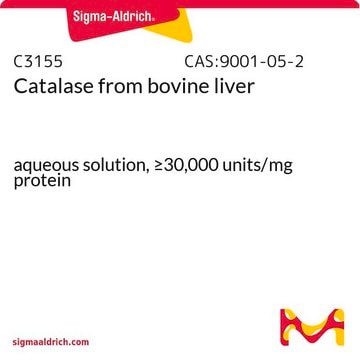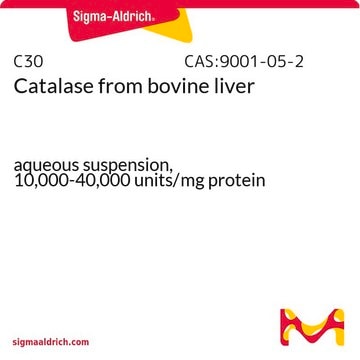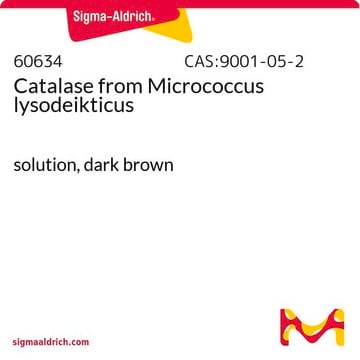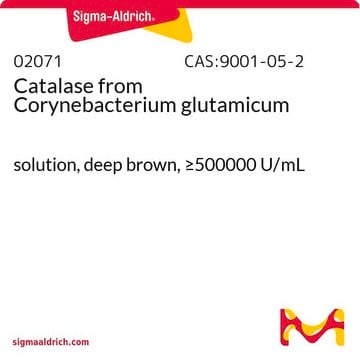E3289
Catalase from bovine liver
≥20000 units/mg protein, lyophilized powder
Synonym(s):
H2O2:H2O2 oxidoreductase
About This Item
Recommended Products
form
lyophilized powder
specific activity
≥20000 units/mg protein
mol wt
tetramer ~250 kDa
composition
protein, ≥60% E405
isoelectric point
5.4
shipped in
wet ice
storage temp.
−20°C
InChI
1S/C9H10O3/c1-2-12-9(11)7-3-5-8(10)6-4-7/h3-6,10H,2H2,1H3
InChI key
NUVBSKCKDOMJSU-UHFFFAOYSA-N
Looking for similar products? Visit Product Comparison Guide
General description
Catalase is encoded by the gene mapped to human chromosome 11p13. Mammalian catalase is an antioxidant enzyme and is a member of hydroperoxidase family). The active enzyme is homotetrameric in nature.
Catalase from bovine liver is a tetramer consisting of 4 equal subunits each with a 60 kDa molecular weight. Each of these subunits contains iron bound to a protoheme IX group. The enzyme will also strongly bind to NADP, where NADP and the heme group are within 13.7 angstroms.
Application
- as a component of gloxy, which is one of the most popular oxygen-scavenging systems.
- in single molecule fluorescence resonance energy transfer (FRET) measurements.
- in cytochrome-C oxidase (COX) histochemistry to study the role of mitochondrial uncoupling protein 2 (UCP2) in limiting oxidative stress during glaucoma.
- to pre-treat slide chambers for total internal reflection fluorescence (TIRF) microscopy.
- in quantifying hydrogen peroxide release.
- to help minimize the effects of reactive oxygen species (ROS) in cooperativity assay for studying doublecortin and microtubule interaction.
Catalase from bovine liver may be used:
- to prepare H2O2-O2 based biocathode for applications in glucose biofuel cells
- to study the kinetic properties and storage stability of catalase immobilized on to florisil
- in glutathione-mediated superoxide generation in an aqueous solution
Biochem/physiol Actions
Unit Definition
Physical form
Signal Word
Danger
Hazard Statements
Precautionary Statements
Hazard Classifications
Resp. Sens. 1
Storage Class Code
11 - Combustible Solids
WGK
WGK 1
Flash Point(F)
Not applicable
Flash Point(C)
Not applicable
Certificates of Analysis (COA)
Search for Certificates of Analysis (COA) by entering the products Lot/Batch Number. Lot and Batch Numbers can be found on a product’s label following the words ‘Lot’ or ‘Batch’.
Already Own This Product?
Find documentation for the products that you have recently purchased in the Document Library.
Customers Also Viewed
Our team of scientists has experience in all areas of research including Life Science, Material Science, Chemical Synthesis, Chromatography, Analytical and many others.
Contact Technical Service













